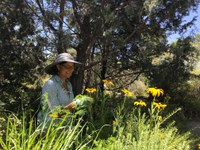New Curator of Plants Brings Fresh Ideas
Aug. 1, 2018 - Maria Thomas’ love for gardening started at an early age—she remembers visiting her grandparents in eastern New Mexico as a young girl and helping out with their harvest. She is now putting her love of gardening to good use as the new curator plants at the ABQ BioPark Botanic Garden.
Although Thomas is new to the position (she started earlier this year), she’s been working at the Botanic Garden since 2006. She brings knowledge of native plants, conservation and landscape design to the job. Prior to starting at the BioPark, she worked in cultural resource management at Valles Caldera and also did some landscaping work on the side.
At the Botanic Garden, Thomas began as the assistant curator for the Japanese Garden where she worked side by side with a landscape designer who helped her learn about interpreting nature and how to replicate the look of the natural world into an exhibit. She’s applied that knowledge into a number of other assignments—she’s worked on the design of the High Desert Rose Garden and Butterfly Pavilion, and the natural landscaping of the new otter exhibit at the Aquarium, among other projects.
In her design, Thomas often takes inspiration from nature. For example, the berms around the atrium at the rose garden were inspired by hikes at Tent Rocks National Monument in northern New Mexico. In the otter exhibit, plants and grasses were chosen from the river otter’s natural habitat in the Taos area. Because she was helping to create a home for the otters, she worked closely with aquarists to accommodate animal needs. “I get really excited about doing what we can from a landscape perspective to create these habitats,” she said.
Thomas believes the ABQ BioPark should play an integral role in building community. “As a native New Mexican, I really want to see that community grow,” she said. “I think we really have a lot of influence,” she added, saying she wants to create something for the community at large and forge new community partnerships.
And, she said, as a public facility, it is important that the garden is a leader in conservation. For instance, Thomas would like to grow the facility’s native seeds and native plants for pollinators programs.
One conservation project Thomas is currently working on involves restoration of vegetation and habitat creation at Ghost Ranch, which endured a severe flood in 2015. She and her team will be giving extra attention to developing habitat that is supportive of drought conditions.
Because of a changing climate, Thomas said she wants to bring the concept of low-water landscaping to the forefront for garden visitors by introducing the community to drought-tolerant plants. Of course, that means the garden will continue its shift toward more drought-tolerant landscaping as well. “At the garden, as we develop, I think that’s key,” she said.
But, Thomas said, she also just wants garden visitors to have a great experience and connect with nature. “It’s so important connecting people to the natural world.”

